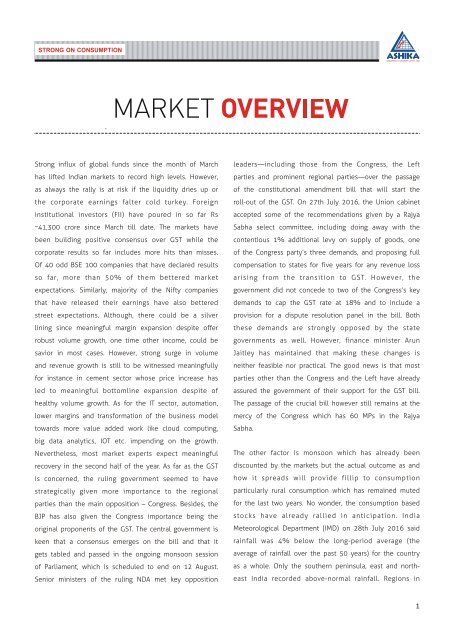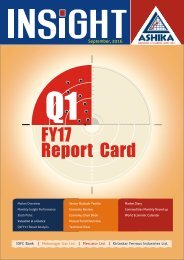Ashika Monthly Insight August 2016
Create successful ePaper yourself
Turn your PDF publications into a flip-book with our unique Google optimized e-Paper software.
STRONG ON CONSUMPTION<br />
Strong influx of global funds since the month of March<br />
has lifted Indian markets to record high levels. However,<br />
as always the rally is at risk if the liquidity dries up or<br />
the corporate earnings falter cold turkey. Foreign<br />
institutional investors (FII) have poured in so far Rs<br />
~41,300 crore since March till date. The markets have<br />
been building positive consensus over GST while the<br />
corporate results so far includes more hits than misses.<br />
Of 40 odd BSE 100 companies that have declared results<br />
so far, more than 50% of them bettered market<br />
expectations. Similarly, majority of the Nifty companies<br />
that have released their earnings have also bettered<br />
street expectations. Although, there could be a silver<br />
lining since meaningful margin expansion despite offer<br />
robust volume growth, one time other income, could be<br />
savior in most cases. However, strong surge in volume<br />
and revenue growth is still to be witnessed meaningfully<br />
for instance in cement sector whose price increase has<br />
led to meaningful bottomline expansion despite of<br />
healthy volume growth. As for the IT sector, automation,<br />
lower margins and transformation of the business model<br />
towards more value added work like cloud computing,<br />
big data analytics, IOT etc. impending on the growth.<br />
Nevertheless, most market experts expect meaningful<br />
recovery in the second half of the year. As far as the GST<br />
is concerned, the ruling government seemed to have<br />
strategically given more importance to the regional<br />
parties than the main opposition – Congress. Besides, the<br />
BJP has also given the Congress importance being the<br />
original proponents of the GST. The central government is<br />
keen that a consensus emerges on the bill and that it<br />
gets tabled and passed in the ongoing monsoon session<br />
of Parliament, which is scheduled to end on 12 <strong>August</strong>.<br />
Senior ministers of the ruling NDA met key opposition<br />
leaders—including those from the Congress, the Left<br />
parties and prominent regional parties—over the passage<br />
of the constitutional amendment bill that will start the<br />
roll-out of the GST. On 27th July <strong>2016</strong>, the Union cabinet<br />
accepted some of the recommendations given by a Rajya<br />
Sabha select committee, including doing away with the<br />
contentious 1% additional levy on supply of goods, one<br />
of the Congress party’s three demands, and proposing full<br />
compensation to states for five years for any revenue loss<br />
arising from the transition to GST. However, the<br />
government did not concede to two of the Congress’s key<br />
demands to cap the GST rate at 18% and to include a<br />
provision for a dispute resolution panel in the bill. Both<br />
these demands are strongly opposed by the state<br />
governments as well. However, finance minister Arun<br />
Jaitley has maintained that making these changes is<br />
neither feasible nor practical. The good news is that most<br />
parties other than the Congress and the Left have already<br />
assured the government of their support for the GST bill.<br />
The passage of the crucial bill however still remains at the<br />
mercy of the Congress which has 60 MPs in the Rajya<br />
Sabha.<br />
The other factor is monsoon which has already been<br />
discounted by the markets but the actual outcome as and<br />
how it spreads will provide fillip to consumption<br />
particularly rural consumption which has remained muted<br />
for the last two years. No wonder, the consumption based<br />
stocks have already rallied in anticipation. India<br />
Meteorological Department (IMD) on 28th July <strong>2016</strong> said<br />
rainfall was 4% below the long-period average (the<br />
average of rainfall over the past 50 years) for the country<br />
as a whole. Only the southern peninsula, east and northeast<br />
India recorded above-normal rainfall. Regions in<br />
1






